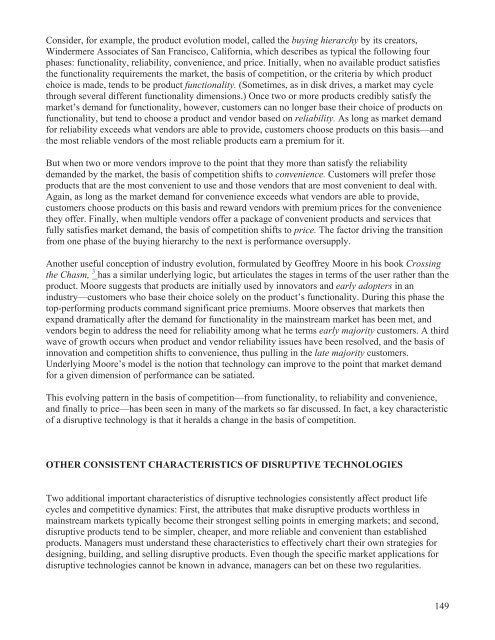PRUEBAS
PRUEBAS
PRUEBAS
Create successful ePaper yourself
Turn your PDF publications into a flip-book with our unique Google optimized e-Paper software.
Consider, for example, the product evolution model, called the buying hierarchy by its creators,Windermere Associates of San Francisco, California, which describes as typical the following fourphases: functionality, reliability, convenience, and price. Initially, when no available product satisfiesthe functionality requirements the market, the basis of competition, or the criteria by which productchoice is made, tends to be product functionality. (Sometimes, as in disk drives, a market may cyclethrough several different functionality dimensions.) Once two or more products credibly satisfy themarket’s demand for functionality, however, customers can no longer base their choice of products onfunctionality, but tend to choose a product and vendor based on reliability. As long as market demandfor reliability exceeds what vendors are able to provide, customers choose products on this basis—andthe most reliable vendors of the most reliable products earn a premium for it.But when two or more vendors improve to the point that they more than satisfy the reliabilitydemanded by the market, the basis of competition shifts to convenience. Customers will prefer thoseproducts that are the most convenient to use and those vendors that are most convenient to deal with.Again, as long as the market demand for convenience exceeds what vendors are able to provide,customers choose products on this basis and reward vendors with premium prices for the conveniencethey offer. Finally, when multiple vendors offer a package of convenient products and services thatfully satisfies market demand, the basis of competition shifts to price. The factor driving the transitionfrom one phase of the buying hierarchy to the next is performance oversupply.Another useful conception of industry evolution, formulated by Geoffrey Moore in his book Crossingthe Chasm, 3 has a similar underlying logic, but articulates the stages in terms of the user rather than theproduct. Moore suggests that products are initially used by innovators and early adopters in anindustry—customers who base their choice solely on the product’s functionality. During this phase thetop-performing products command significant price premiums. Moore observes that markets thenexpand dramatically after the demand for functionality in the mainstream market has been met, andvendors begin to address the need for reliability among what he terms early majority customers. A thirdwave of growth occurs when product and vendor reliability issues have been resolved, and the basis ofinnovation and competition shifts to convenience, thus pulling in the late majority customers.Underlying Moore’s model is the notion that technology can improve to the point that market demandfor a given dimension of performance can be satiated.This evolving pattern in the basis of competition—from functionality, to reliability and convenience,and finally to price—has been seen in many of the markets so far discussed. In fact, a key characteristicof a disruptive technology is that it heralds a change in the basis of competition.OTHER CONSISTENT CHARACTERISTICS OF DISRUPTIVE TECHNOLOGIESTwo additional important characteristics of disruptive technologies consistently affect product lifecycles and competitive dynamics: First, the attributes that make disruptive products worthless inmainstream markets typically become their strongest selling points in emerging markets; and second,disruptive products tend to be simpler, cheaper, and more reliable and convenient than establishedproducts. Managers must understand these characteristics to effectively chart their own strategies fordesigning, building, and selling disruptive products. Even though the specific market applications fordisruptive technologies cannot be known in advance, managers can bet on these two regularities.149


